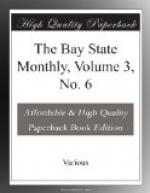* * * * *
AMESBURY: THE HOME OF WHITTIER.
BY FRANCES C. SPARHAWK.
Amesbury is only a town. It has defects that would strike a stranger, and beauties that one who has learned to love them never forgets; they linger in glimpses of wood and hill and river and lake, and often rise unbidden before the mind’s eye. The poet Whittier says that those who are born under the shadow of Powow Hill always return sometime, no matter how far they may have wandered. He himself, though not Amesbury born, has found it impossible to desert the old home, full of associations and surrounded by old friends. He always votes in Amesbury, and he often spends weeks at a time in his old home. The river that he has sung, the lake that he has re-christened, the walks and drives with which he is so familiar, all exercise their spell upon him; he loves them, just as he loves the warm hearts that he has found there and helped to make warm and true.
But what a stranger would first notice in coming into town is, that the houses, instead of being on land regularly laid out for building, seem to have grown up here and there and everywhere, a good deal in accordance with their own sweet wills, and without the smallest regard to surroundings.
But there are handsome houses in Amesbury, and these are growing more numerous every year. The people themselves would assert that the walks and drives about the village, the hills and the river are the things to be longest remembered about the place. If they were inclined to boasting, they might say also that they had as good a right as any people in America to be considered of ancient stock, for some of the names of the earliest settlers are the familiar names in the town to-day, and few towns in America are older than Amesbury. The names Barnard, Challis, Weed, Jones, and Hoyt, appear on the first board of “Prudenshall,” and that of Richard Currier as town clerk. This was in April, 1668, the year after the new town was named.




